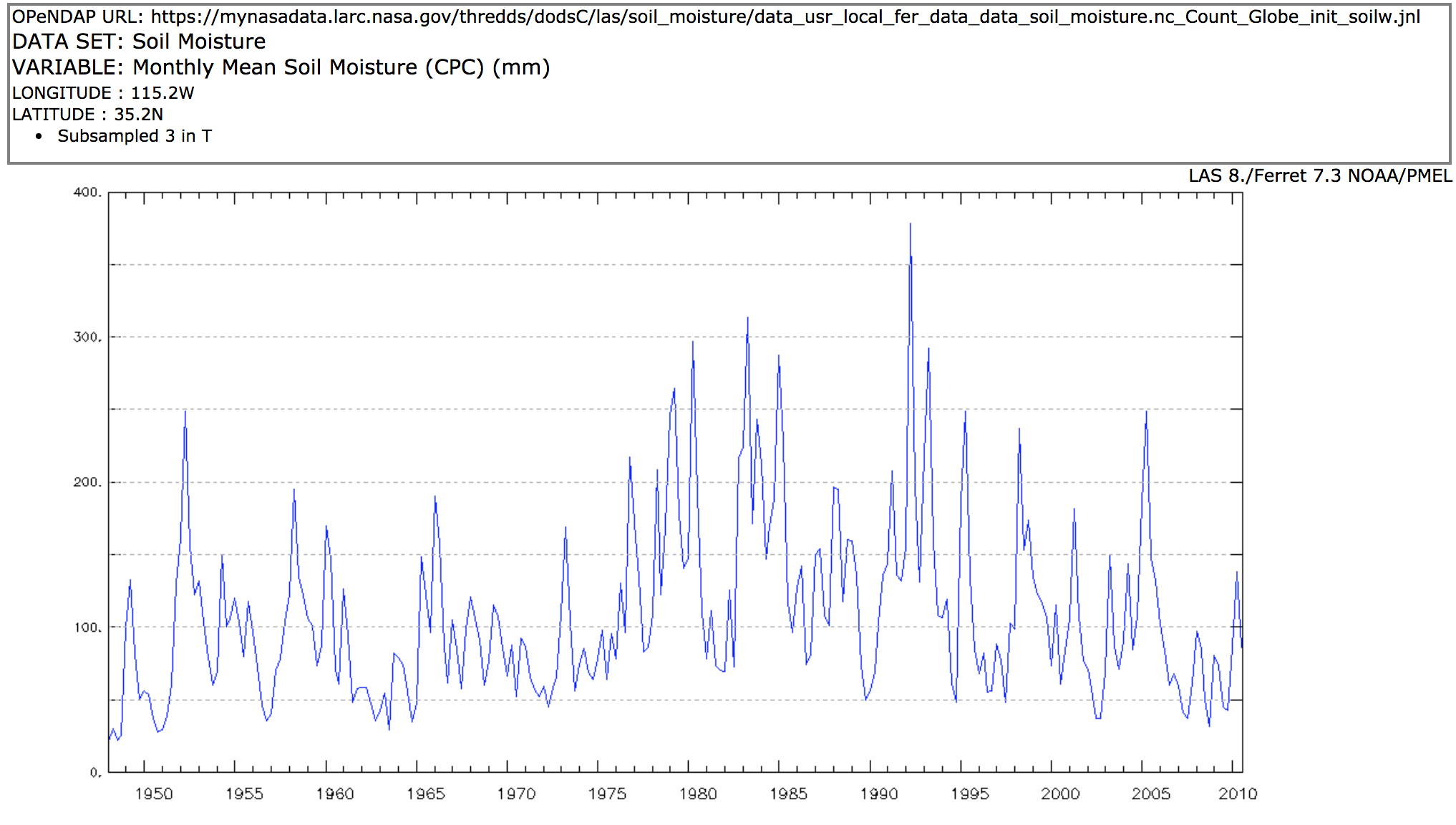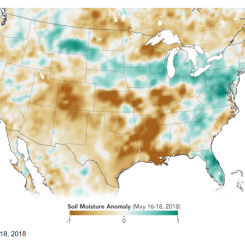Lesson Plans
Simple Soil Moisture Measurement Stations
Overview
In this activity, students investigate three different soil samples with varying moisture content. They use a soil moisture probe to determine the percentage (by volume) of water in each of the soil samples.
Materials Required
- 3 round plant pots
- 3 soil samples with varying degrees of moisture content (dry, intermediate, very wet)
- 3 soil moisture probes
Procedure
Setting Up the Stations: There will be three stations (labeled Station 1, Station 2, Station 3). Each Station will have a plant pot, a soil sample, and a soil moisture probe.
1.) Set up each of the three stations with the designated materials. Leave one sample of soil dry, add a moderate amount of water to the second sample, and thoroughly wet the third sample. Randomly place the pots of soil at the three stations.
2.) Have students start with Station 1 and rotate through each of the three stations making the required observations/measurements and answering all three sets of questions on their data sheet.
Station 1: (Plant pot, soil sample, and soil moisture probe)
1.) Without using the soil moisture probe, what level of soil moisture do you think this sample is? (Circle One) Dry, Intermediate, Very Wet
2.) Without using the soil moisture probe, what do you think the percentage of water content is in the soil sample? ___%
3.) Is this type of guessing a good estimate in determining soil moisture? Why or Why not?
4.) Now use the soil moisture probe, measure the % of water in the sample in 5 spots and record that number.
1.___% 2.___% 3.___% 4.___% 5.___%
5.) Now, find the average of all the numbers to determine the % of water in the soil. ___%
Station 2: (Plant pot, soil sample, and a soil moisture probe)
1.) What level of soil moisture do you think this sample is? (Circle One) Dry, Intermediate, Very Wet
2.) What do you think the percentage of water content is in the soil sample? ___%
3.) Using the soil moisture probe, measure the % of water in the sample in 5 spots and record that number.
1.___% 2.___% 3.___% 4.___% 5.___%
4.) Now, find the average of all the numbers to determine the % of water in the soil. ___%
Station 3: (Plant pot, soil sample, and a soil moisture probe)
1.) What level of soil moisture do you think this sample is? (Circle One) Dry, Intermediate, Very Wet
2.) What do you think the percentage of water content is in the soil sample? ___%
3.) Using the soil moisture probe, measure the % of water in the sample in 5 spots and record that number.
1.___% 2.___% 3.___% 4.___% 5.___%
4.) Now, find the average of all the numbers to determine the % of water in the soil. ___%
Discussion Questions:
1.) Was it easy or difficult to guess the % of soil moisture without using the soil moisture probe?
2.) Why did we take 5 different soil measurements at each station?
3.) Why is soil moisture important?
4.) Why is it important to be able to measure soil moisture?
5.) Why would using probes like you did at the different stations be difficult for everyone around the world to do to monitor soil moisture?
Discuss as a class the importance of NASA soil moisture missions such as the SMAP (Soil Moisture Active Passive) Mission which monitors soil moisture in the top 5 cm of the soil on Earth. By monitoring soil moisture using satellites, scientists can provide valuable insight for those within the agriculture and natural disasters communities to enable them to make informed decisions.
Disciplinary Core Ideas:
Crosscutting Concepts:
- Systems and System Models
Science and Engineering Practices:
- Asking Questions and Defining Problems
- Developing and Using Models
- Planning and Carrying out Investigations
- Analyzing and Interpreting Data
- Using Mathematics and Computational Thinking
- Obtaining, Evaluating and Communicating Information
- Learners will understand the importance of using a soil moisture probe to accurately measure soil moisture
- Learners will discuss the importance of soil moisture
-
What is Soil Moisture?
-
Why is Soil Moisture important?
-
Why is it important to accurately measure soil moisture?
What is Soil Moisture?
Soil moisture is difficult to define because it means different things in different disciplines. For example, a farmer's concept of soil moisture is different from that of a water resource manager or a weather forecaster. Generally, however, soil moisture is the water that is held in the spaces between soil particles. Surface soil moisture is the water that is in the upper 10 cm of soil, whereas root zone soil moisture is the water that is available to plants, which is generally considered to be in the upper 200 cm of soil.
Why is Measuring Soil Moisture Important?
Compared to other components of the hydrologic cycle, the volume of soil moisture is small; nonetheless, it of fundamental importance to many hydrological, biological and biogeochemical processes. Soil moisture information is valuable to a wide range of government agencies and private companies concerned with weather and climate, runoff potential and flood control, soil erosion and slope failure, reservoir management, geotechnical engineering, and water quality. Soil moisture is a key variable in controlling the exchange of water and heat energy between the land surface and the atmosphere through evaporation and plant transpiration. As a result, soil moisture plays an important role in the development of weather patterns and the production of precipitation. Simulations with numerical weather prediction models have shown that improved characterization of surface soil moisture, vegetation, and temperature can lead to significant forecast improvements. Soil moisture also strongly affects the amount of precipitation that runs off into nearby streams and rivers. Soil moisture information can be used for reservoir management, early warning of droughts, irrigation scheduling, and crop yield forecasting.
Soil Moisture is the amount of water contained in the pore space of the unsaturated zone. The unsaturated zone is the portion of the soil profile which contains both air and water. NASA's SMAP (Soil Moisture Active & Passive mission) measures the moisture content of the top ~5 cm of the soil profile. These surface layer measurements will be used in computer models to produce estimates of the soil moisture in the root zone, as well as estimates of evapotranspiration, infiltration/exfiltration, and recharge to groundwater.
- Geoscientists - Research physical properties of the earth, such as rocks, soils, and other materials.
- Soil and Plant Scientists - Explore the breeding, production, and management of crops, trees, and plants.
- Conservation Scientists - Research, manage and protect natural resources like soil, forests, and water.
- Atmospheric and Space Scientists - Investigate weather and climate-related phenomena to prepare weather reports and forecasts for the public
- Earth Drillers, Except Oil and Gas - Explore minerals and soil properties through a variety of drilling and testing measures.
- Agricultural Engineers - Solve problems that are related to the way farms work.
- Computer and Information Scientists - Conduct research in the field of computer and information science
- Remote Sensing Scientists and Technologists - Research a variety of topics using techniques that allow the study of an object or phenomena without making contact directly with the object such as analyzing geological and geographical data. They typically work with aerial or satellite pictures.







